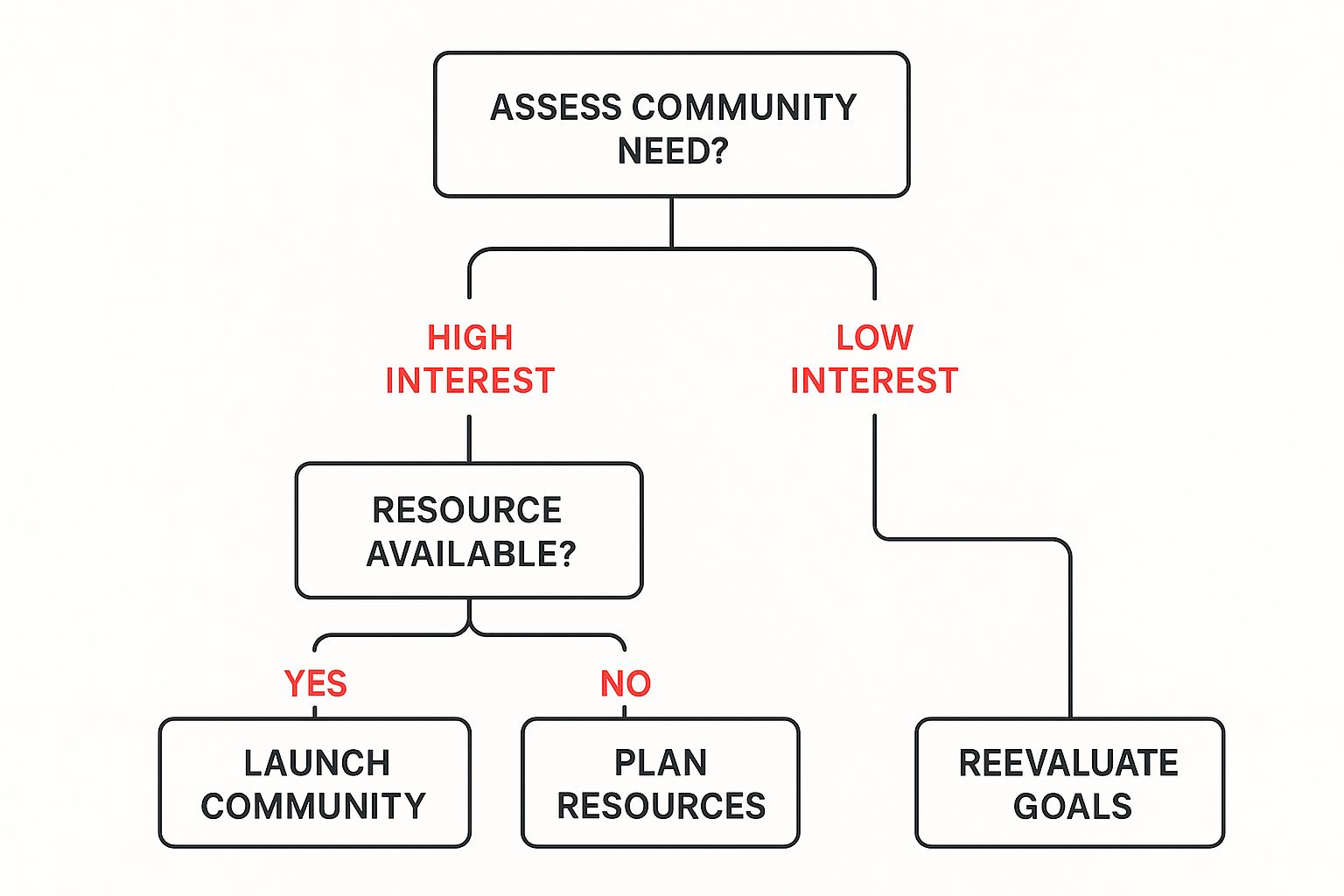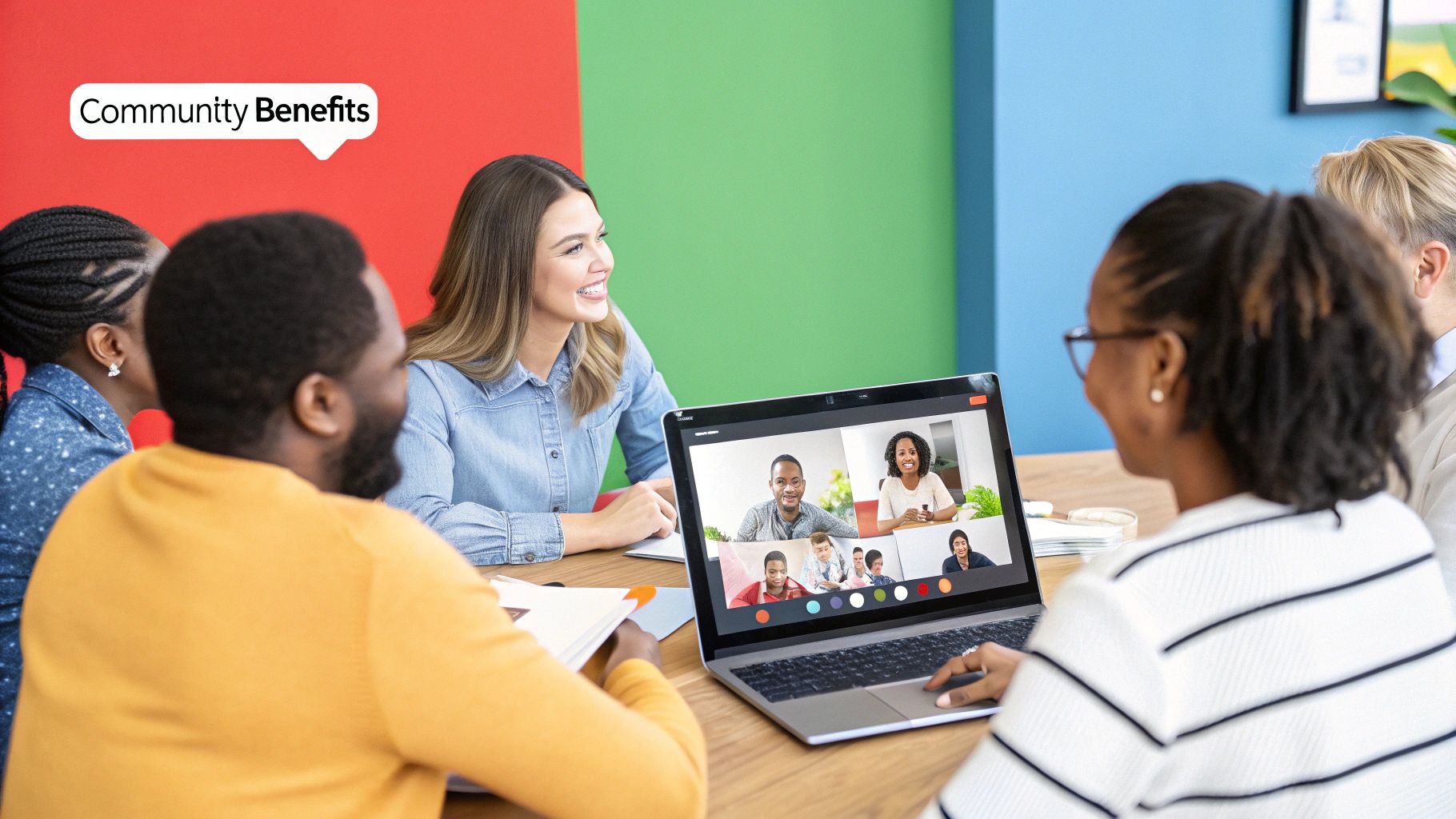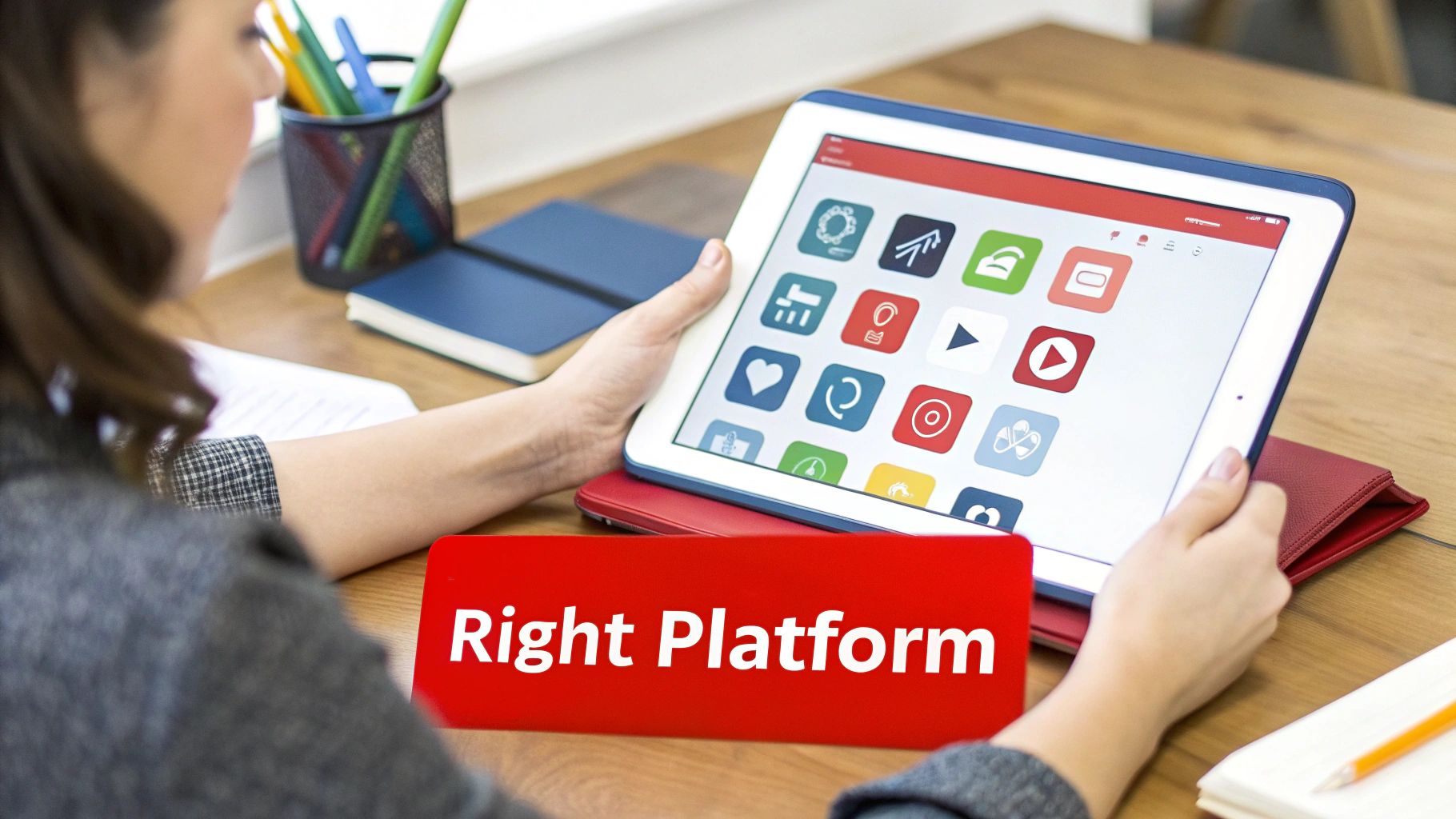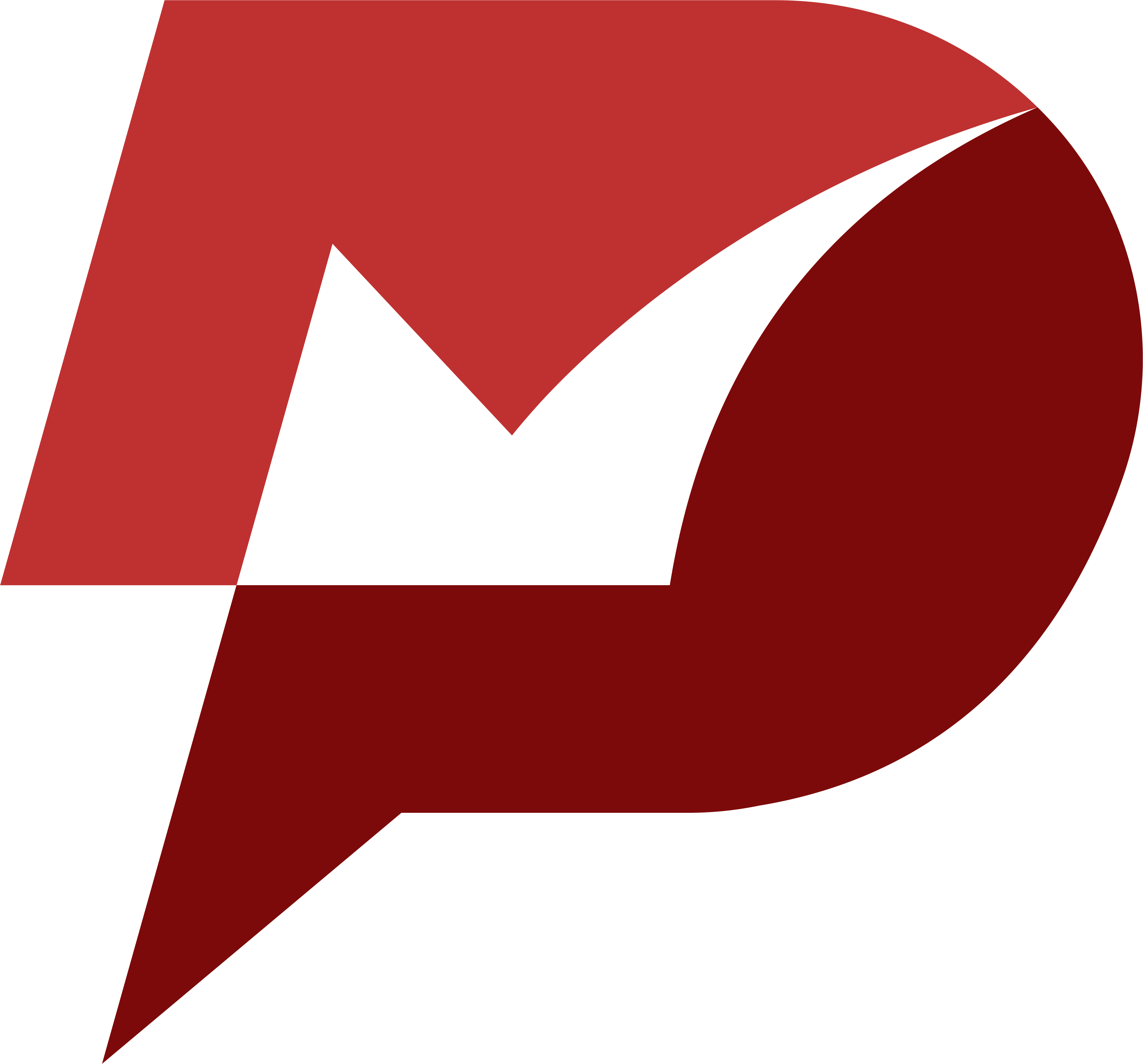Building an online community is so much more than just gathering followers. It's about creating a living, breathing space where people with a shared passion can connect, share, and feel like they belong. This is where you turn passive scrollers into an active, tight-knit group that genuinely values being part of what you've built.
It all starts with a clear vision, knowing exactly who you want to bring together, and picking the right digital "home" for your conversations.
Define Your Community's Core Purpose
Before you even think about platforms or content calendars, you have to ask the most important question: Why should this community even exist?
A powerful purpose is the foundation of any group that lasts. Without it, you’re just creating an empty room that will struggle to attract the right people—and keep them there. This isn’t about some generic mission statement; it's about nailing down a clear, compelling reason for being that your ideal members will instantly connect with.
Skipping this step is like trying to build a house without a blueprint. Sure, you might get something standing, but it won't be a place anyone actually wants to live in.
What Problem Are You Actually Solving?
Every great community, at its heart, solves a problem or fills a gap in someone's life. Your first job is to get crystal clear on what that is.
Are you building a space for freelance writers to swap client horror stories and beat the isolation of working from home? Or maybe it's a supportive hub for new parents navigating those sleepless nights?
Think about the unique value you're bringing to the table. This could be:
- Sharing Knowledge: A place for members to learn from you and each other.
- Making Connections: Helping professionals in the same field find one another.
- Offering Support: Creating a safe zone for people going through similar life challenges.
- Celebrating a Passion: Uniting fans of a niche hobby, a rising artist, or a specific brand.
The potential audience out there is huge. With internet access expected to reach over 5.6 billion people by early 2025, your niche group has a global pool of millions to draw from.
Figure Out Who Your Ideal Member Is
Once you’ve figured out your "why," it's time to define your "who." This means creating a detailed persona of your ideal community member—and it goes way beyond just age and location. You need to get inside their head and understand their hopes, frustrations, and what they're trying to achieve.
Our own guide on how to identify your target audience is a great place to start if you need a deeper dive.
Ask yourself these questions to flesh out your persona:
- What are their biggest pain points related to your community's topic?
- Where do they hang out online and what kind of content do they love?
- Which social media platforms are they already using every day?
- What would make them feel truly seen and heard in a group setting?
This persona becomes your North Star. It will guide every single decision you make, from the platform you pick to the tone of your very first welcome post. You're building for them, not just for a faceless crowd. If you want more guidance on setting a strong foundation, check out these expert tips on building a thriving online community.
Choose the Right Home for Your Community
With your purpose and ideal member locked in, you can finally pick the right platform. This decision has to be strategic. Don’t just jump on the bandwagon with the most popular app; think about what will actually serve your members and your goals.
For instance, something like a Facebook Group can be fantastic for reaching a broad audience with a low barrier to entry. They're familiar and easy for people to join.

This decision is about finding the best fit. To help you think it through, here's a quick comparison of the most common options.
Choosing the Right Community Platform
Deciding where to build your community is a critical first step. This table breaks down the pros and cons of different platform types to help you match your goals with the right environment.
| Platform Type | Best For | Key Strengths | Potential Challenges |
|---|---|---|---|
| Social Media Groups (e.g., Facebook, LinkedIn) | Broad-interest topics, brand-adjacent communities, and groups where accessibility is key. | High user familiarity, built-in discovery tools, no cost to start. | Competing with algorithms, limited customization, platform owns the data. |
| Forum Software (e.g., Discourse, Vanilla) | Niche hobbies, technical support, and deep, long-form discussions that need to be archived. | Excellent for organization, SEO benefits, fosters in-depth conversations. | Can feel dated, higher barrier to entry for new members, requires hosting. |
| Chat Apps (e.g., Discord, Slack, Telegram) | Real-time interaction, gaming communities, project collaboration, and fast-paced engagement. | Instantaneous communication, high engagement, great for creating a "live" feel. | Conversations can be chaotic and hard to follow, not ideal for searchable content. |
| Dedicated Platforms (e.g., Circle, Mighty Networks) | Course creators, membership sites, and businesses wanting full control over their brand experience. | All-in-one solution (courses, events, community), full data ownership, monetization tools. | Monthly subscription costs, requires migrating users to a new platform. |
Ultimately, the best platform is the one where your members already feel comfortable and that gives you the tools you need to create the specific experience you've envisioned.
Creating Content That Fuels Conversation
An empty community feels like a party with no music. Your content is the beat that gets people talking, sharing, and connecting. The goal isn't to just broadcast information; it’s to create a space where members feel like they have to jump into the conversation.
Think of your content as kindling for the community's fire. Without it, even the most interested members will just be silent spectators. A good content plan is what makes a community feel alive and welcoming right from the start.
Go Beyond Basic Questions
The easiest way to start a conversation is to ask a question, right? But the quality of your question dictates the quality of the conversation. Asking "What are your goals for this week?" is fine, but it’s generic and can feel like homework.
Instead, you want to craft prompts that tap into real emotions, experiences, and opinions. These are the kinds of questions that don’t have one "right" answer and naturally invite people to share personal stories.
Here’s the difference:
- Weak Prompt: "Any questions about our new feature?"
- Strong Prompt: "We just launched our new 'Project Template' feature. What's the one tedious task you're most excited to finally automate with it?"
See how that little shift changes everything? It turns a simple support query into a shared celebration of solving a common headache. It gets people talking and sharing positive experiences. For more on this, check out our guide on how to create engaging content.
Build a Balanced Content Calendar
When you're trying to build momentum, consistency is your best friend. A content calendar doesn't need to be some complex beast—a simple spreadsheet is all you need. The trick is planning a healthy mix of content that serves different purposes.
A good rule of thumb is the 80/20 rule. Plan for roughly 80% of your content to be purely focused on giving value, sparking discussion, and helping members. You can save the remaining 20% for your own announcements or promotions.
Following this approach builds a ton of trust and makes sure your community never feels like one long sales pitch.
A community is a place of contribution, not just consumption. When you consistently provide value, members feel a natural desire to give back, whether through their own insights, helping others, or becoming loyal customers.
Spotlight Your Members
One of the most powerful things you can do is make your members the heroes of the story. People love being recognized, and featuring their successes and stories is a huge win for everyone. It makes them feel seen and provides authentic, relatable content for the rest of the group.

Here are a few simple ways to put the spotlight on your members:
- Member of the Week: Pick someone who has been super helpful or hit a big milestone. Share their story (with their permission, of course!) and get everyone to cheer them on.
- Showcase Member Projects: Start a regular thread where people can share what they're working on. For a community of graphic designers, this could be a "Feedback Friday" post.
- User-Generated Content (UGC) Contests: Run a simple contest asking members to share a photo or story related to your community's theme. The prize can be as easy as a feature on your main social page.
Doing this turns passive scrollers into active co-creators of your community's culture.
Host Interactive Community Events
Static posts are your bread and butter, but live events can seriously supercharge engagement. They create a much stronger sense of connection by breaking up the routine and giving members a reason to show up at the same time for a shared experience.
Think about adding a few of these to your calendar:
- Ask Me Anything (AMA) Sessions: Bring in an industry expert—or even yourself—to answer questions live. This provides a ton of direct value.
- Live Workshops or Tutorials: Host a live training session on a skill your members care about. If you run a community for bakers, you could host a live sourdough starter workshop.
- Virtual "Coffee Chat" Meetups: Schedule an informal, unstructured video call where members can just show up and chat. These are fantastic for pure relationship-building.
The massive growth in social media users, from 970 million in 2010 to a projected 5.24 billion by 2025, shows just how many people are out there looking for genuine connection. By offering these kinds of interactive events, you give them a valuable alternative to just endlessly scrolling. They are a fantastic way to cut through the noise and build the kind of authentic engagement that makes a community truly thrive.
Getting Your First 1,000 Members on Board
That first climb, from zero members to a few hundred, often feels like the steepest. It’s a ghost town at first, and you’re the one who has to get the party started. The good news? You don't need a huge marketing budget. What you need is a smart, personal approach that builds on the connections you already have.
Think of your first members as your founding partners. They’re the ones who will set the tone for everything that follows. They’ll start the first conversations and create that welcoming vibe that pulls everyone else in. They aren't just an audience; they're the foundation.
Start with the People Who Already Know You
Before you go looking for strangers, look closer to home. The people most likely to join your community are the ones who already know, like, and trust you. This is your low-hanging fruit—the perfect seed to get things growing.
But don't just blast a generic invite to everyone. You need a more thoughtful strategy. Make people feel like they’re getting a special, exclusive invitation.
- Your Email List: These folks have already raised their hands and said they want to hear from you. Send them a personal email explaining why you're starting this community. Spell out the unique perks they’ll get for being one of the first to join.
- Your Social Media Followers: You've spent time building an audience on platforms like Instagram, TikTok, or Twitter. Now's the time to lean on that. Create posts that tease the community's value and make it incredibly easy for them to join, probably through a clear "link in bio."
Create an Invitation They Can't Refuse
How you ask is just as important as who you ask. A weak invitation gets scrolled past and forgotten. A great one makes joining feel like an unmissable opportunity. Your job is to make the value crystal clear and build some genuine excitement.
A good invitation instantly answers three questions for someone:
- What is this, exactly? (e.g., A private community for faceless content creators.)
- What’s in it for me? (e.g., Direct access to experts, exclusive templates, and a network that gets it.)
- Why should I join now? (e.g., Be one of the founding members who helps shape our culture.)
A powerful invitation isn't just a link; it's a story. It tells people where you're going and invites them to help build the path. Frame it as a chance to be part of something new and influential from the very beginning.
For instance, instead of a flat "Join my new Facebook group," try something with more punch: "I'm hand-picking the first 50 members for The Creator's Lab, a private space where we'll share monetization secrets nobody else is talking about. Want in as a founding member?" This approach feels exclusive and creates a little bit of urgency.
Go Where Your People Already Are
After you’ve tapped into your immediate network, it’s time to branch out. This means showing up in the online spaces where your ideal members are already hanging out. The goal isn't to spam these places with links but to become a helpful, familiar face.
Think about the ecosystem of your niche. If your community is for people who are masters of YouTube automation, where are they spending their time online?
- Relevant Forums and Subreddits: Find places like the r/PartneredYouTube subreddit or other niche forums. Don't just drop a link and run. Stick around. Answer questions, offer real advice, and participate in discussions. Once you've built up some credibility, you can naturally mention your community when it actually helps someone.
- Complementary Social Media Groups: Look for Facebook or LinkedIn groups that serve a similar—but not identical—audience. Again, engage authentically. You might even connect with the group admin to see if they’re open to a collaboration or a "community swap."
- Team Up with Other Creators: Find creators or brands who serve your audience but aren't direct competitors. You could co-host a webinar, do an Instagram Live together, or just agree to give each other's communities a shout-out. This is a shortcut to a pre-vetted, highly relevant audience. A software company that makes tools for creators, for example, could be a perfect partner. This strategy of borrowing trust from an established voice is one of the fastest ways to grow and build credibility right out of the gate.
Nurturing Engagement and Member Loyalty
Getting people to join your group is just the first step. The real work—and the real magic—happens after they arrive. A truly thriving community isn't about the member count; it's about the daily hum of conversation, the connections being made, and the energy people bring to the space. This is where you pivot from simply attracting people to making them want to stay.
If you don't actively nurture your community, it'll lose steam. It’s that simple. The trick is to build a culture where people feel safe, heard, and valued. That means setting clear ground rules, actually listening to what people want, and empowering your members to help shape the community right alongside you.
Create a Safe and Respectful Environment
Before anyone will open up and engage, they need to feel safe. A community without clear guidelines is a recipe for chaos, and it won't be a welcoming place for long. Laying down a few simple, firm rules is non-negotiable if you want to create a space where people feel comfortable enough to share their thoughts.
Your rules don't need to be a massive legal document. Just cover the basics:
- Be Kind and Courteous: A simple "treat others with respect" goes a long way in heading off problems.
- No Hate Speech or Bullying: Make it crystal clear that there's a zero-tolerance policy for harassment.
- No Promotions or Spam: You have to protect your members from a constant barrage of sales pitches. Keep the focus on real conversation.
- Respect Everyone's Privacy: Establish a clear understanding that what's shared in the group, stays in the group.
These guidelines set the tone for everyone. They also give your moderators—even if that's just you starting out—a clear playbook for keeping discussions healthy and productive. When members see you actively and fairly moderating, it shows them you genuinely care about their experience.
Actively Listen and Act on Feedback
Want to know the fastest way to build loyalty? Show your members you're listening. Your community shouldn't be a monologue where you broadcast messages at people. It should be a living, breathing space that evolves based on what your members actually need and want.
Make a habit of asking for feedback. It’s easier than you think:
- Run simple polls. Ask things like, "What kind of weekly event would you get the most out of?" or "Which topic should our next Q&A cover?"
- Post open-ended questions. A thread asking, "If you could change one thing about this community, what would it be?" can unearth some real gems.
- Pay attention to organic conversations. If you notice several people are running into the same problem, that's your cue to create a resource that helps them solve it.
But here’s the key: listening is only half the battle. The real magic happens when you act on that feedback. When members see their suggestions come to life, they stop being passive observers and become active co-creators. That sense of ownership is what builds fierce, long-term loyalty.
Recognize and Reward Your Top Contributors
In any community, you'll notice a small group of people who seem to drive a huge chunk of the conversation. These are your champions. They're the ones answering questions, welcoming new faces, and consistently adding value. Shining a spotlight on them is one of the best things you can do to encourage that kind of positive behavior across the board.
Recognizing them doesn't have to be a big, expensive production. Small, meaningful gestures work wonders:
- A "Member of the Month" shout-out to celebrate their contributions.
- A unique flair or a special badge next to their username.
- Early access to new content or upcoming features.
- An invitation to become a moderator or community ambassador.
These little acts of appreciation make your most valuable members feel seen. It reinforces the exact behaviors you want to see more of, making your community a better place for everyone.
Spark Participation with Challenges and Events
Organic conversation is the lifeblood of a community, but sometimes, it needs a little spark to get going. Structured activities like challenges or member-led events can inject a fresh dose of energy and give people a specific reason to jump in.
Just look at a platform like Reddit, which is built on an incredible number of niche communities. The r/AskReddit community, for example, is a masterclass in this. It thrives on simple, open-ended questions that absolutely anyone can answer.

This screenshot shows how one single, interesting question can pull in thousands of comments, creating a massive shared experience. You don't always need complex content to get people talking; sometimes, all you need is the right prompt. The incredible success of Reddit, which expects to grow to over 556 million users by 2028, is built on this very principle of user-driven content. (You can dig deeper into how platforms do this by exploring these social media statistics and insights).
By creating fun, low-stakes activities, you make it easy for even your quietest members to get involved. And if you can empower members to host their own small events or discussions? That’s when you’re on your way to building a community that is truly self-sustaining and deeply loyal.
Measuring Community Health and Proving Its Value

So, how can you tell if all your hard work building a community is actually working? It’s easy to get excited as the member count goes up, but that number doesn’t paint the full picture. A truly healthy community is buzzing with conversation and connection, not just a massive, silent audience.
To get the real story, you have to dig into the data. This isn't about vanity metrics; it’s about finding meaningful insights that help you make smarter decisions, prove your community's worth, and get the resources you need to keep it growing. It all comes down to tracking the right Key Performance Indicators (KPIs) that tie back to your business goals.
It’s Not Just About the Member Count
First things first, let's redefine what success looks like. I'd much rather have a community of 500 active, helpful members than one with 10,000 people who never say a word. The real health of your community is measured by the activity inside it, not just the names on the roster.
Think of it this way: a coffee shop owner doesn't just count people walking in the door. They look at how many folks buy a coffee, how long they stick around, and how often they come back. You need to bring that same mindset to your online space.
To really get a feel for the pulse of your group, you need to learn how to measure community engagement effectively and look past the superficial numbers. This is how you spot the real patterns of interaction that tell you you've built a healthy, self-sustaining group.
Key Metrics for Community Health
To get a clear picture of your community's health, it’s best to focus on a handful of core metrics that track everything from daily activity and long-term loyalty to the actual impact on the business.
Here’s a quick breakdown of what you should be looking at.
Key Metrics for Community Health
| Metric Category | Example KPI | What It Measures | Why It Matters |
|---|---|---|---|
| Activity & Growth | Monthly Active Users (MAU) | The number of unique members who post, comment, or react in a given month. | Shows how many people are consistently finding value, not just lurking in the shadows. |
| Engagement | Posts Per Day/Week | The volume of new conversations being started by members. | A high number is a great sign of a lively, active space where people feel comfortable sharing. |
| Retention | Member Churn Rate | The percentage of members who leave or go inactive over a specific period. | Low churn means you've built a valuable community that people want to stick with. |
| Business Value | Reduced Support Tickets | A decrease in customer support requests as members find answers within the community. | Directly demonstrates ROI by showing how the community cuts down on operational costs. |
Ultimately, tracking this stuff isn't about making fancy reports. It's about getting real, actionable insights. The data should tell you a story about what your members need, what content they love, and where you should focus your energy next.
Setting Up a Simple Tracking Dashboard
You don't need a complex, expensive tool to get started. Honestly, a simple spreadsheet can work just fine as your community health dashboard. The most important thing is consistency. Block out time each week or month to plug in your numbers so you can start seeing trends emerge.
Your dashboard should track the core KPIs you’ve chosen. For example, you could have columns for:
- Total Members: Your baseline for tracking overall growth.
- New Members This Month: Shows you how well your acquisition efforts are working.
- Active Members (MAU): This is the true pulse of your community.
- Number of New Posts: A direct indicator of user-generated conversations.
- Average Replies Per Post: This tells you about the depth of the conversations.
When you track these consistently, you can start asking better questions. For instance, if active members are dropping but new posts are up, it could mean a handful of super-users are dominating the conversation. For a more structured approach to monitoring these trends, check out our guide on https://monetizedprofiles.com/blogs/monetization-on-social-media/social-media-report-analysis.
Connecting Your Community to Business ROI
At the end of the day, the most powerful thing you can do with your data is prove your community's return on investment (ROI). This is what gets stakeholders to listen and secures the budget you need.
Let’s say you sell monetized accounts. A strong community can directly boost your bottom line by generating sales leads from discussions or providing feedback that leads to product improvements. We've seen that a healthy community can cause a 28% drop in support ticket volume because members start helping each other out. That's real time and money saved, and proving that value is how you build a community that lasts.
Got Questions? Let’s Talk Community Building
https://www.youtube.com/embed/6ZVpufakwfk
When you're diving into building an online community, a few questions always seem to pop up. Whether you're laying the first brick or trying to expand your digital town square, let's clear up some of the common hurdles you might face.
I get asked about growth, engagement, and how to keep the lights on all the time. Getting these things right from the start can save you a lot of headaches down the road.
How Much Time Does This Actually Take?
This is the million-dollar question, and the real answer is, "it varies." When you're just getting started, plan on spending at least a few hours every week. You'll be the one creating content, personally welcoming new faces, and getting conversations off the ground.
As your community gets bigger, this can easily turn into a part-time gig or even a full-time job.
But you don't have to be glued to your screen 24/7. A pro tip is to batch-create your content and use scheduling tools. This frees you up to focus on what really matters: interacting with your people. For most growing communities, a dedicated 1-2 hours per day is a sweet spot for making real progress.
When Is the Right Time to Start Charging?
Timing is everything here. If you ask for money too soon, you risk scaring off the very people who helped you build the foundation. Wait too long, and you'll burn yourself out working for free.
A good rule of thumb is to wait until you have a solid core of active members who genuinely love being there.
Look for these signs before you think about monetizing:
- Conversations are happening on their own, without you having to start every single one.
- People are telling you—unprompted—how much they value the group.
- You have a clear idea for a premium offering, like exclusive content, a special course, or direct access to you.
This way, you’re charging for something that’s already proven its worth.
Don't rush to monetize. First, build a space people can't imagine leaving. The revenue will follow the value you create, making the transition feel natural and earned rather than abrupt and transactional.
What Do I Do If It’s Crickets in There?
Ah, the sound of silence. It’s every community manager's biggest fear, but it's usually fixable. If nobody's talking, it often just means they need a little nudge and a clear invitation to jump in.
Make it super easy for people to participate. Try simple, low-effort prompts like polls, quick questions, or a "share your wins this week" thread. Don't be afraid to tag a few members who you think might have a great answer.
Most importantly, be the most active person in the room. Your energy is contagious. If you consistently show up and engage, others will eventually follow your lead and the silence will fade.
Ready to fast-track your content creation journey? MonetizedProfiles provides monetization-approved social media accounts, perfect for faceless creators who want to start earning from day one. Get your fully approved YouTube or TikTok account and skip the grind at https://monetizedprofiles.com.









